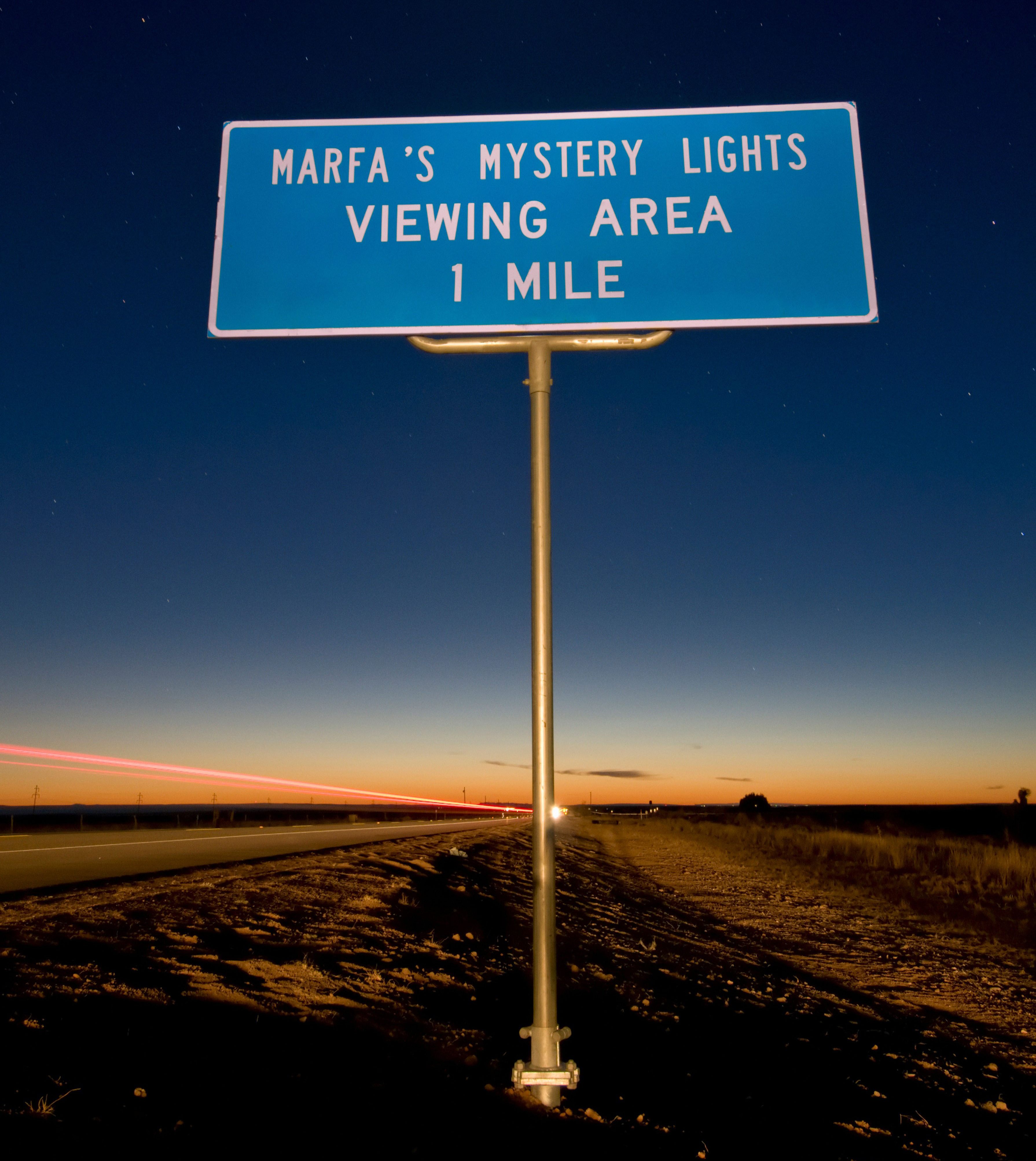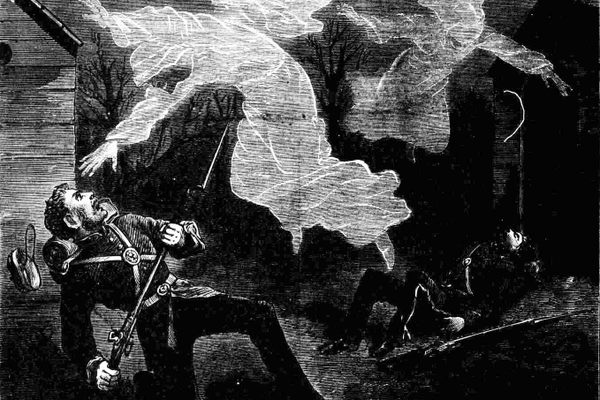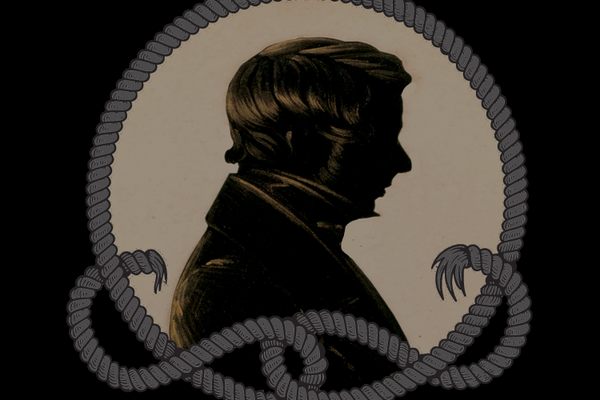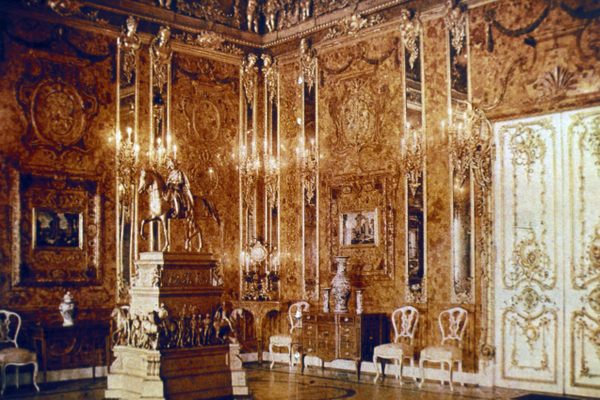Searching for ‘Spooklights’ in Southern Georgia
This rural region may be the will-o’-the-wisp capital of America.
I’m sitting in my car at midnight, alone on a dirt road in rural Georgia. I’m tired, but I can’t go to sleep. Not because of the bobcats or the wild hogs I’ve been warned about. Not because of the gators or the rattlesnakes. Not because the sounds of night are intensified because I’m alone in the dark, with a three-quarter waxing gibbous moon hanging in the sky.
No, I can’t go to sleep because I’m here to see a ghost. And if I fall asleep, I may not see it—but it might see me. Then, just when I’m about to give up and get the hell out of here, I see a bright, circular light coming toward me from the distance.
Much earlier that day, I drove for four hours from my home in Atlanta to almost nobody’s home in Cogdell, Georgia—a town that consists of just a few buildings on dirt roads, surrounded by timber woods and blueberry fields. Cogdell is in Clinch County, just off the northwestern edge of the Okefenokee Swamp—the largest swamp in North America. Hence the gators.

I came here to see the Cogdell “spooklight,” which has been spotted in the area for at least the past 60 years, and likely farther back than that. And now it may be coming my way.
Spooklights are a global phenomenon described in a remarkably consistent manner in the many places they’ve been spotted. Also known as earth lights, ghost lights, will-o’-the-wisps, and by many other names, they’re generally described as balls of light that float like purposeful balloons. Often they’re found near swamps and marshlands, and associated with ghost stories. Some say they resemble lanterns, and in the days before electricity, were said to lead confused nighttime travelers to their doom.
Most non-supernatural theories on their origins involve phosphorus gases rising from beneath swampy water. The most famous spooklights in the United States are probably the Marfa Lights in Texas, or the Ozark Spooklight that appears near the intersection of Missouri, Kansas, and Oklahoma. But there are entire books describing other spooklights in more than a dozen states, throughout the United Kingdom, and around the world.

Within an hour or so of Cogdell, there are at least four other documented spooklights—documented internet-wise, anyway—in the towns of Pearson, Axson, Surrency, and Screven. There are also stories about spooklight sightings in Fargo, another small town in Clinch County, and other places just a few miles from Cogdell. You might say that the area north of the Okefenokee is the spooklight capital of America.
The story behind Cogdell’s spooklight is connected to the fascinating history of Cogdell itself. The town was settled in 1914 by a man named Alexander Kelly Sessoms, who gave it his mother’s maiden name: Cogdell. Sessoms, who owned most of the area’s forests, built a sawmill and turpentine still, and brought in hundreds of laborers to work them.
Cogdell was the definition of a company town. At the Cogdell store and post office—long closed but still standing today—employees used what were referred to as “babbitts”: company currency that could only be spent there. Employees lived in company housing, with white residents on the north side of the main dirt road and black residents on the south side.
Alongside the main road stood railroad tracks built by Sessoms to move his products between the cities of Lakeland and Waycross (with Cogdell in the middle). One of the tracks’ builders was a self-taught railway and construction engineer named Kince Charles Davis. Though hated by the Ku Klux Klan—for being a Black man with a white man’s job—Davis was protected by Sessoms and other powerful local men thanks to his remarkable ability to build a railroad.

Perhaps even more remarkable were the children he raised, including the actor, writer, and civil-rights activist Ossie Davis and his brother William Conan Davis, a food chemist whose formulas for instant mashed potatoes, potato chips, and soft-serve ice cream have influenced the diet of nearly every American.
Today, the tracks are long gone, replaced by GA-122, which runs alongside the dirt road where the spooklight is said to appear—the dirt road where I’m waiting alone in the dark. Only a handful of homes on the north side of the road remain; fewer are occupied. The south side, where the Black laborers and their families once lived, has been completely grown over by woods.
The railroad track supplies one of the legends behind the Cogdell spooklight. The story goes that when the tracks were being built, a railroad conductor was hit by a train and killed. The spooklight is supposedly the lantern of his ghost, still swinging in a vain effort to stop the train. Other takes on the Cogdell light talk of a decapitated conductor seeking his lost head, and a servant forever waiting in the dark for the owner of the plantation where he worked.
I drove to Cogdell not only to see the light but also to talk to people who’d seen it themselves. At the office of The Clinch County News—10 miles south of Cogdell, in Homerville—I spoke with Len Robbins, the newspaper’s editor and publisher for the past 25 years.

Robbins hasn’t seen the spooklight himself, but subscriber JoAnn Tomlinson has. Now 73, the retired principal and teacher at Clinch County High School was a teenager living in Homerville back in 1963. One night that year she and her friends packed themselves into two cars and drove up to Cogdell.
When they arrived, around midnight on a moonless night, they crossed the tracks and turned right on the dirt road, drove east for a couple of miles, then turned around and faced west, toward Cogdell. They turned off their headlights and stayed very quiet and still. Then they saw the light.
Tomlinson says it appeared along the edge of the woods on the north side of the road—a beach ball–size mass, 10 or 15 feet off the ground. It floated out of the trees. Then it re-entered the woods. Then it floated out again. “By that time everybody in both cars were scared to death,” Tomlinson says.
The other car, the one she wasn’t in, cranked the engine to flee. But then something even crazier happened. The light—which Tomlinson describes as glowing a mossy green, with a bit of chartreuse—floated over to one of the car’s headlights, as if doing so intentionally. Then it bounced to the other headlight, went beneath the car, and came out under the back of the vehicle, by the license plate.
At that point both cars sped away. As Tomlinson looked back, she saw the light return to the trees.
She says she doesn’t know what the light was—only that it scared the heck out of her and her friends. And that she’s seen it more than once.

“I don’t believe in ghosts,” says Tomlinson. “I don’t believe dead people are coming after me. If they were, they’d have got me in the 51 years I have been living out there.” (For most of her life, she’s lived 10 miles down the road from Cogdell, near Arabia Cemetery—a boneyard built on sand that’s nearly white, as if the headstones were simply placed upon a tropical island beach.) “But I do know that I saw that green mass, not once but twice. And the second time my mother was in the car.”
Bonnie Adams grew up in Cogdell, worked at the company store, and is one of the only people still living on the north side of the road. She told me that when she was young, people used to come from all over and knock on her family’s door, asking where to find the spooklight—and annoying her father.
“My dad would come back in,” she recalls, “and he’d say, ‘Another one of those nuts come looking for the spooklight.’” Some of those visitors, she says, came all the way from Texas just to see it.
Adams’s father would joke that you wouldn’t see the light unless you had a good-looking woman with you. Many people told me that back in the day, going out to the dirt road to see the spooklight—some say it’s green, others white, still others orange—was really just an excuse for teenagers to neck in a dark, isolated spot.
But that was only one of many viewing conditions cited by locals. Some say you have to go at midnight, and that you can’t see the light until three in the morning. Some say that there hasn’t been a spotting in 50 years, while others claim to have seen the light in the 2000s. Some say that you won’t see it unless the moon is new; others say it has to be full. Some say if you’re driving, the light—which may arrive accompanied by the sound of a cowbell—will stop your engine. (It happened to Adams’s nephew.)

I’d been told to take the paved road, drive about two miles east, go past the gator farm, and turn left over the borrow pits, onto one of the dirt turnoffs. Then turn the car around on the old dirt road and face Cogdell, just like JoAnn Tomlinson and countless other teenagers had done.
I sat there, alone. Nobody to make out with. Midnight. The moon neither full nor new. It was October, but as warm as a summer night.
At first I kept the windows closed and listened to the radio. Every 15 minutes or so, a car would drive by, bringing light and relief. But the later it got, the fewer cars passed. After an hour, I turned off the radio, opened the windows, and just listened to the night. I thought about Ossie Davis’s memories of his hometown.
“Cogdell had one country store where the railroad and the dirt road intersected,” he wrote in a memoir co-authored by his late wife, Ruby Dee. “It had two or three churches for Black folks, a lot of woods and paths and gatherings of shanties here and there where the Black folks lived.

“Cogdell, of course, has vanished; it is no more, gone with the wind carrying down with it all the small things that made it seem that someday it might be a city as big and as important as Homerville.” Even the cemetery had grown over, Davis lamented. Nobody knows where his grandmother is buried.
After more than two hours sitting in the car, with nobody but the crickets for company, I noticed the air suddenly become foggier. That’s when I saw the orange light. It came from over a hill. Not in front of me, but behind me. I spotted it first in my rearview mirror, then nearly broke my neck turning around to see it directly.
Would it bounce off my headlights? Do a subtle dance in the air? Or play the lantern and try to stop a phantom train?
I’d never know. Because after a few seconds, I realized it wasn’t a spooklight at all. It was just another car, driving 45 mph past Cogdell, off to who-knows-where in the dead of night.





















Follow us on Twitter to get the latest on the world's hidden wonders.
Like us on Facebook to get the latest on the world's hidden wonders.
Follow us on Twitter Like us on Facebook